Just before Earth Day, in 1970, Cathy the dolphin committed suicide in Richard O’Barry’s arms, changing his life forever.

The Cove, a documentary that covertly captures a dolphin slaughter in the Japanese fishing village of Taiji, won the Audience Award at the 2009 Sundance Film Festival. The protagonist is Richard O’Barry, Flipper’s dolphin trainer, who became a rabid animal rights crusader after Cathy the dolphin committed suicide in his arms.
“She looked me right in the eye, took a breath, held it—and she didn’t take another one,” O’Barry recently told New York Magazine. “She just sank to the bottom of the water. That had a profound effect on me.”
O’Barry helped capture and train the dolphins on “Flipper,” which didn’t exactly make him a friend of animal rights activists. Now, he is the star of one of the biggest animal rights films in years, “The Cove,” a documentary that covertly captures a dolphin slaughter in the Japanese fishing village of Taiji. He credits Cathy’s suicide as the turning point that transformed him from animal captor to animal liberator.
For Americans, O’Barry’s suicide story may seem ridiculous. Science tells us that animals can’t intentionally kill themselves. But Native Americans view animal suicide and death in general much differently.
“The non-native mindset is so fearful,” said Maya Piñon, a Native-born naturalist who is working on a book about animal suicide. “The culture to which I was born tells me there is nothing to fear about death. Sure, you fight to live as long as you can, but when that moment comes, you’re like, ‘Okay, game over, I’ve gone on to the next dimension.’”
Piñon is of Eastern Woodland Indian descent and was raised with native values. She grew up in a rural area, in nature. “Most of my playmates were not human beings,” she said. “I always had animals and critters.”
She drew her worldview from the stories of elders, which did not separate man from animal. “We are all part of creation in Native American cosmology,” said Piñon. “The creator is the creation is the creator.”
Animals show signs of awareness all the time, but most people miss them or misinterpret them. For example, a common hunting story is that a large stag locks eyes with a hunter and then strides directly at him, marching right into his bullets. “People say, ‘Stupid deer, he doesn’t even know this guy is going to shoot him,’” said Piñon.
But might this story actually portray an animal that is willingly giving its life to the hunter?
“Hunters would rather brag about the 15-point buck they just bagged,” said Piñon, “and not that Grandpa Buck said today is the day to die, and I am giving you my body.”
The difference may be in how one regards science.
“I think the mistake we tend to make in this culture is to turn everything over to scientists and let them have the last say,” said Piñon. “From a Native American cosmology, that is foolhardy because everything is related, and there are always at least three reasons for something.”
One of Piñon’s most potent animal suicide stories doesn’t involve a Native American but a scientifically-minded worker at a Cornell University nature center. The man heard brakes screech outside and ran to the road to find that a woman had hit a woodchuck. The rear end of the animal was flattened, and it was dragging itself in circles with its two front legs. Thinking to end its misery, the man fetched his supervisor, and the two returned with a baseball bat. As they walked toward the woodchuck, it stopped panicking and stared at them. Then, it dragged itself down the road, into a ditch, up an embankment, and into a pond. “This is a non-swimming mammal making a conscious decision to drown itself,” said Piñon.
Death by drowning is a common theme in the animal suicide stories Piñon has collected for her book. But, some animals choose far more gory exits, like her good friend’s German shepherd, which lived to a ripe old age and then lay down in front of a train.
Animal suicides can vary, Piñon explained, just like human suicides. And they can be just as difficult to define.
“Someone who chain smokes and comes from a family of chain smokers is on a slow-motion death spiral,” she said. “The other end of the spectrum is someone who juggles nitroglycerine. Is that a slow-motion suicide or tempting fate?”









